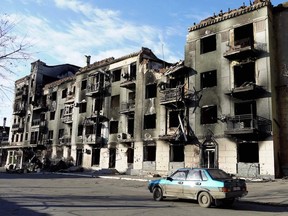From a humanitarian perspective, we need only consider the catastrophe that was averted
Get the latest from Adam Zivo straight to your inbox

Some pundits say that Ukraine is receiving too much foreign support — but the money being given is relatively modest and has already tremendously paid off. From both a humanitarian and security perspective, supporting Ukraine is among the best investments we’ve made in a generation.
Since February 2022, Canada has committed roughly $3.9 billion in aid ($1 billion in military aid and $2.9 billion in humanitarian aid). That sounds like a huge sum, but, in the context of government spending, it isn’t.
The NP Comment newsletter from columnist Colby Cosh and NP Comment editors tackles the important topics with boldness, verve and wit. Get NP Platformed delivered to your inbox weekdays by 4 p.m. ET.
Canadian military aid to Ukraine amounts to roughly four per cent of the defence budget, while humanitarian aid is equal to roughly 35 per cent of our international development budget. Total Canadian aid to Ukraine amounts to only 0.6 per cent of the federal government’s 2021 expenditures, or around 0.15 per cent of total GDP.
American aid has been similarly modest when put into proper context. The Biden administration aims to provide $77.7 billion in aid to Ukraine for 2022, more than half of which has been earmarked for defence. That amounts to only 5.6 per cent of the United States’ annual defence spending, or 0.3 per cent of GDP.
Political leaders and pundits who claim that Canada and the United States are emptying their coffers to aid Ukraine are either financially illiterate or wilfully misleading the public.
It’s difficult to understate how much has been achieved by sending Ukraine only a spec of our GDP.
From a humanitarian perspective, we need only consider the catastrophe that was averted by thwarting Russia’s invasion. Every time a region of Ukraine has been liberated, civilians have shared horror stories of torture, wanton killings, mass kidnappings of children and the attempted eradication of Ukrainian culture.
War is not a video game — these are real people who suffered real, unconscionable pain. By providing Ukrainians with the means to defend themselves, we’ve prevented tens of millions of human beings from experiencing a similar fate. Considering that Russia is now trying to win the war by destroying Ukraine’s electrical grid and freezing civilians, the humanitarian case for aid will only get stronger.
It’s notable that some Canadian voices on the far left, who usually support aid for beleaguered peoples, have suddenly discovered a burning concern about the federal budget when it comes to Ukrainian humanitarian aid.
These voices have never made a peep about other humanitarian investments, nor did they make a peep when Canada’s overall international development budget rose by $1.8 billion between 2020 and 2021. It’s almost as if they only dislike humanitarian aid when it helps Ukrainian civilians.
Some might argue that we have no obligation to save the world and must look out for our own interests first — but supporting Ukraine clearly benefits us, too.
The United States has been able to cripple one of its main rivals while spending comparative peanuts. Having lost half of its original fighting force, Russia now relies on poorly-trained conscripts. Russian weapons reserves have been depleted and the country’s economic base has been hobbled by sanctions and a mass exodus of fighting age men. With direct wartime expenditures costing Russia at least six per cent of its GDP this year, it’s questionable whether the Kremlin will be able to restore its arsenals anytime soon.
While Russia remains a dangerous threat to weaker adversaries, it now lacks the capacity to launch larger expansionist campaigns into Eastern Europe. In the spring, many worried about whether a Ukrainian defeat would destabilize the region, risking escalation and global chaos. Aiding Ukraine has prevented that outcome. So long as this aid continues, it seems likely that Putin’s war will remain a regional conflict.
Supporting Ukraine has also restored confidence in American power, which was sorely lacking after the United States’ disastrous pullout from Afghanistan. For a generation, the U.S. mired itself in unsuccessful, morally questionable “forever wars” in the Middle East. Ukraine marks a new, more legitimate chapter in American foreign policy — finally, an intervention has been not only effective, but unquestionably just.
-

Adam Zivo: Putin has plunged Kyiv into eerie darkness, but Ukrainians will not be deterred
-

Adam Zivo: Vladimir Putin's weakness exposed in Ukraine's Kherson liberation
The close tether between Canada and the United States means that what’s good for one country is typically good for the other. However, Canada has its own security interests in Russia’s defeat.
Canadian arctic sovereignty is an increasingly important issue as global warming opens up valuable shipping channels in our northern territories. Canada’s hold over the arctic has always been tenuous, and policymakers are increasingly worried that Russia and China will impose themselves in this region in the medium or long term.
To preempt this threat, Canada is heavily investing into modernizing its navy. The Royal Canadian Navy hopes to purchase 15 new ships at the cost of $84.5 billion. Operating and maintaining these ships over the next 65 years will cost an estimated $220 billion. That averages out to an annual cost of $4.7 billion.
If Russia eventually concedes defeat and stops occupying Ukrainian lands, the Kremlin’s capacity to project force into the arctic could be severely hampered for a generation. China would, of course, remain a risk to our arctic sovereignty, but resisting one adversary is easier than resisting two.
That makes supporting Ukraine a smart security investment for Canadians — the modest sums spent today could have huge payoffs years from now. Canadian aid has not, and cannot, be a gamechanger in Ukraine, but our continued support solidifies the alliance of nations safeguarding Ukrainians from colonial subjugation.
National Post
Get the latest from Adam Zivo straight to your inbox







